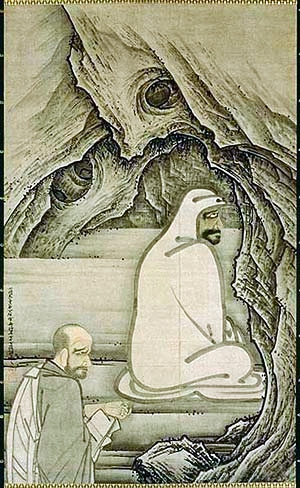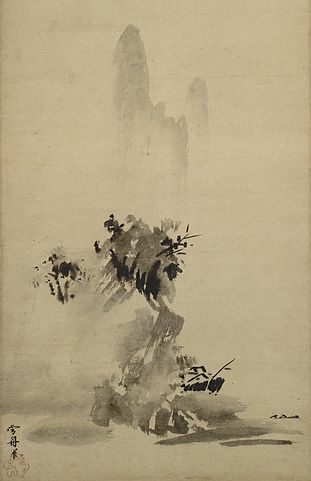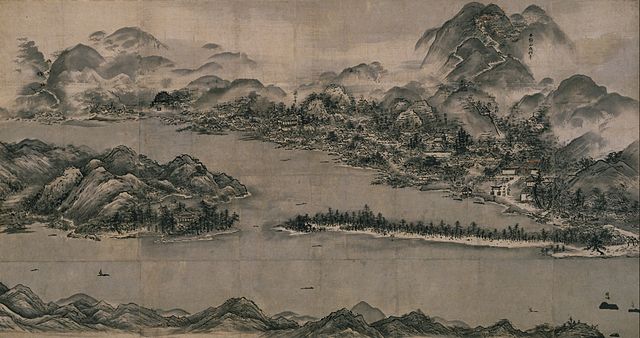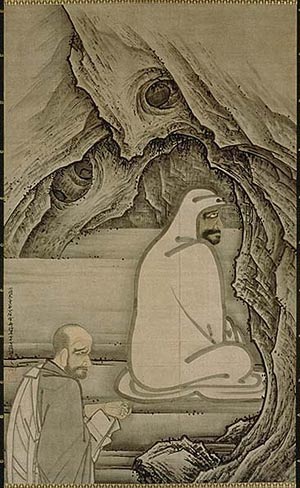Sesshū Tōyō and Buddhist art: Is Huike paying respect to Bodhidharma?
Lee Jay Walker
Modern Tokyo Times

The Japanese artist, Sesshū Tōyō (1420-1506), never questioned the Buddhist faith but in an artistic sense, he felt constrained by the time of his day. Indeed, the stunning and intriguing art piece titled Huike Offering His Arm to Bodhidharma leads to many questions that remain unanswered. After all, Sesshū Tōyō can’t answer for himself because he long left this world and no documentation remains about the “bigger meaning.”
It is widely speculated that Sesshū Tōyō felt crushed at times by the rigid nature of Rinzai Buddhism in relation to his art. Sengai Gibon (1750-1837), also belonging to Rinzai Buddhism, felt a similar feeling. However, Sengai Gibon challenged the status quo in order to reach all Japanese citizens, irrespective of wealth or status – and he used humor irrespective of any negative reactions.

The art piece titled Huike Offering His Arm to Bodhidharma says much about Sesshū Tōyō. Notably, this art piece is dated for being completed in 1496. In other words, in the late stages of his life, Sesshū Tōyō felt freer. Hence, does this amazing art piece apply to his personal self – and a meaning much higher in relation to freedom and deference?

If you view the art piece, then is Huike showing deference and utmost respect towards Bodhidharma? After all, it is known Bodhidharma had rejected Huike on several occasions. Therefore, Huike cuts his arm off but in the art piece, he clearly isn’t looking at Bodhidharma in awe.
On the contrary, while the art piece provides a mysterious aura to Bodhidharma and shows his power by being ranked higher than Huike, it does not show any piety from Huike. Given this reality, then why did Huike cut his arm off if no sense of love, passion, piety, or admiration within the art piece by Sesshū Tōyō?

Irrespective if Sesshū Tōyō is aiming the meaning to be a metaphor – or it was solely focused on the topic at hand – it highlights the “free will” of the artist even if the meaning is hidden. Of course, the real meaning will never be known. Equally, to other viewers, it may be deemed that Huike Offering His Arm to Bodhidharma is based on respect.
In my interpretation – stress, “my own,” – I believe that in the late stages of his life he desired to show aspects of his lifelong unhappiness in being restrained by the conditions of his day. Hence, Huike is Sesshū Tōyō and Bodhidharma represents the rigid nature of this period of Japanese history in the field of religious art.

Modern Tokyo News is part of the Modern Tokyo Times group
DONATIONS to SUPPORT MODERN TOKYO TIMES – please pay PayPal and DONATE to sawakoart@gmail.com
http://moderntokyotimes.com Modern Tokyo Times – International News and Japan News
http://sawakoart.com – Sawako Utsumi personal website and Modern Tokyo Times artist
https://moderntokyonews.com Modern Tokyo News – Tokyo News and International News
http://global-security-news.com Global Security News – Geopolitics and Terrorism
PLEASE JOIN ON TWITTER
https://twitter.com/MTT_News Modern Tokyo Times
PLEASE JOIN ON FACEBOOK